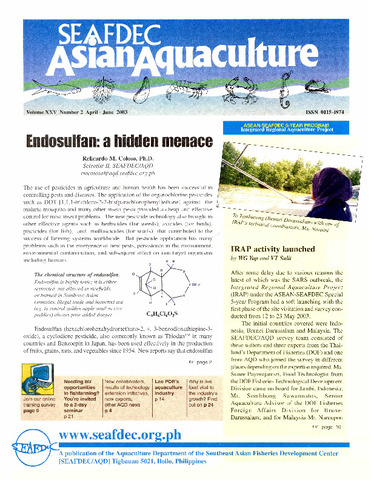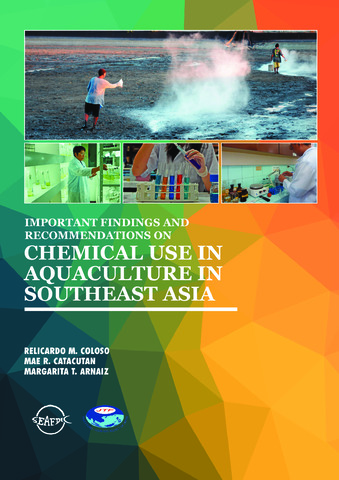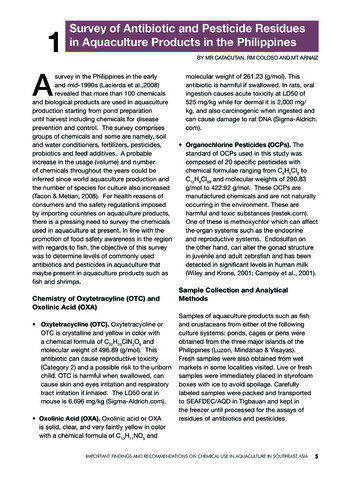Growth and photosynthesis inhibition by agricultural pesticides in three freshwater microalgae.
- Global styles
- MLA
- Vancouver
- Elsevier - Harvard
- APA
- Help

View/
Date
2002Page views
1,186ASFA keyword
AGROVOC keyword
Taxonomic term
Metadata
Show full item record
Share
Abstract
Growth rate and photosynthesis of Microcystis aeruginosa, Scenedesmus quadricauda and Aulacoseira granulata exposed to different concentrations of the agricultural pesticides CNP (p-nitrophenyl 2,4,6-trichlorophenyl ether), MEP [O,O-dimethyl O-(3-methyl-4-nitrophenyl) thiophosphate], ISP [isoprothiolane (C12H18O4S2)], and TBT (tri-n-butyltin chloride) were determined. The effective concentration (EC50) for growth and photosynthesis in each species of microalga was then calculated. Inhibition of growth and photosynthesis in the three microalgae was greatest when exposed to CNP and TBT. Microcystis aeruginosa and A. granulata showed a higher tolerance, whereas S. quadricauda showed a higher sensitivity. Except for MEP, the EC50 values for growth obtained in the three microalgae were higher than those for photosynthesis. The growth–photosynthesis response relationship showed that, for CNP and TBT, growth of the three organisms tested were less inhibited than their photosynthesis at a lower exposure (0.001–0.05 μg/L). At a higher exposure (0.10–1.0 μg/L), the response between relative growth rates and relative photosynthesis was proportional. For MEP and ISP, a proportional response existed between relative growth rates and relative photosynthesis in all test organisms. These results suggest that the inhibition of growth and photosynthesis by agricultural pesticides differs for the three microalgae. The differences can be explained in terms of the physico-chemical properties of the four pesticides and the physiological and morphological properties of the three microalgae.
Suggested Citation
Guanzon, N. G., Jr., & Nakahara, H. (2002). Growth and photosynthesis inhibition by agricultural pesticides in three freshwater microalgae. Fisheries Science , 68(1), 144-151. https://doi.org/10.1046/j.1444-2906.2002.00400.x
Type
ArticleISSN
0919-9268Collections
- Journal Articles [1258]
Related items
Showing items related by title, author, creator and subject.
-
Endosulfan: a hidden menace
Coloso, Relicardo M. (Aquaculture Department, Southeast Asian Fisheries Development Center, 2003)A clean and healthy environment is paramount to human existence. While pesticide use has successfully sustained agricultural and food production in our lifetime as well as safeguarded human health by controlling insect ... -
Important findings and recommendations on chemical use in aquaculture in Southeast Asia
Coloso, Relicardo M.; Catacutan, Mae R.; Arnaiz, Margarita T. (Aquaculture Department, Southeast Asian Fisheries Development Center, 2015)Under the program of Fisheries Consultative Group of the ASEAN (Association of South-East Asian Nations) - SEAFDEC (Southeast Asian Fisheries Development Center) Strategic Partnership Mechanism, a research project entitled ... -
Survey of antibiotic and pesticide residues in aquaculture products in the Philippines
Catacutan, Mae R.; Coloso, Relicardo M.; Arnaiz, Margarita T. (Aquaculture Department, Southeast Asian Fisheries Development Center, 2015)A survey in the Philippines in the early and mid-1990s (Lacierda et al.,2008) revealed that more than 100 chemicals and biological products are used in aquaculture production starting from pond preparation until harvest ...





